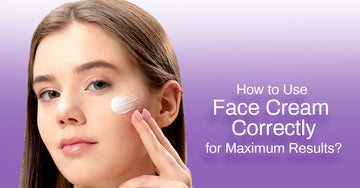Face cream is one of the simplest but most important products in your skincare routine — but are you really using it the right way? Many people spend good money on creams, hoping for glowing, smooth skin, but don’t see the results they want.
The problem often isn’t the product — it’s how you apply it.
At CurexPK, we believe real skincare results come from a smart routine done right every day. When you understand how to use face cream correctly for maximum results, you help your skin look its best, stay healthy, and age beautifully.
This in-depth guide explains everything you need to know: how to prep your skin, how much product to use, how to apply it for the best absorption, when to use it, how to pair it with other products, and common mistakes that hold people back.
Why Does How You Apply Face Cream Matter?
Face cream works by sealing in moisture, strengthening your skin barrier, and sometimes delivering active ingredients that target dryness, aging, or dullness. But it only works properly if it’s absorbed into clean skin — and layered at the right step in your routine.
If you rush your application or use it incorrectly, you might block your pores, waste product, or keep your skin from benefiting from the rest of your routine.
Step 1: Start With a Proper Cleanse
Always apply face cream on freshly cleaned skin. Why? Dirt, makeup, sweat, and excess oil sit on your skin during the day. If you slap cream on top of all that, it just traps impurities and keeps your active ingredients from working.
Do this:
- Use a gentle cleanser that matches your skin type — foam or gel for oily skin, cream or oil-based for dry or sensitive skin.
- Wash your face with lukewarm water. Hot water can strip your natural oils, leaving you drier.
- Gently pat dry with a clean towel — never rub harshly.
Step 2: Apply to Damp Skin for Better Absorption
This is a game-changing tip that many people miss. When your skin is still slightly damp (not dripping wet), it’s more permeable. That means it absorbs your cream’s hydrating ingredients better.
Pro tip:
- Right after cleansing, apply your toner (if you use one).
- Don’t wait for your skin to fully dry — apply your serum and then your face cream while your skin is still moist.
This locks in hydration and prevents moisture loss.
Step 3: Use the Right Amount
Applying a thick layer won’t make your cream work faster. Too much can clog pores and feel greasy; too little may not hydrate you enough.
How much do you really need?
- A pea-sized to dime-sized amount for your entire face is enough.
- If your skin is extra dry, you can add a tiny bit more at night.
- Warm the cream between your fingers to help it spread evenly.
Step 4: Dot, Then Smooth With Upward Motions
How you apply your face cream affects your skin’s elasticity and overall look. Tugging or pulling can lead to micro-tears over time.
How to do it properly:
- Dab small dots on your forehead, both cheeks, nose, and chin.
- Using your fingertips, gently spread the cream in upward, outward strokes. This helps lift the skin and boosts circulation.
- Never drag downwards — it works against gravity.
- Don’t forget your neck! Apply cream upward from your collarbone
Step 5: Layer Products in the Correct Order
You’d be surprised how many people ruin a great cream by putting it on at the wrong step.
Correct order:
- Cleanser
- Toner (optional, but helpful)
- Treatment or serum
- Eye cream (if you use one)
- Face cream — this locks in everything underneath.
- Sunscreen (in the morning only, always last step!)
Your face cream’s job is to seal in the hydration and protect your barrier. If you apply it before your serum, the serum’s ingredients may not reach your skin properly.
Step 6: Use Day and Night Creams for Maximum Benefit
Your skin has different needs at different times of the day.
- Day cream: Should be lightweight, fast-absorbing, and protective. Look for antioxidants like Vitamin C, and SPF if possible, to shield against pollution and UV rays.
- Night cream: Usually richer, more nourishing, and sometimes includes ingredients that help with cell repair while you sleep, like peptides, hyaluronic acid, or gentle exfoliants.
Not sure which to use? Explore our full hydrating day and night face creams to find the best match for your skin.
Step 7: Never Skip Sunscreen — Your Cream Can’t Do It All
Your face cream hydrates and protects your barrier, but it can’t fully defend you against UV damage. Even if your day cream has SPF, it might not be enough on its own. Always finish your morning routine with a broad-spectrum sunscreen.
Extra Tips for Maximum Results
Here are some small but powerful habits to boost your cream’s performance:
- Patch test new creams: This helps avoid unexpected breakouts or reactions.
- Adjust seasonally: Use a lighter formula during hot, humid months and a richer one in cold or dry weather.
- Use clean hands: Always wash your hands before dipping into a jar or pump. Dirty fingers can contaminate your cream.
- Store it properly: Keep your cream in a cool, dry place away from direct sunlight. Don’t store it in a hot bathroom cabinet if it gets too warm.
- Stay consistent: Even the best product won’t work overnight. Use your cream every morning and night for best results.
5 Common Mistakes to Avoid
- Skipping moisturizer if you have oily skin: Oily skin needs hydration too. Dehydrated skin often produces more oil to compensate. Pick a lightweight, non-comedogenic cream.
- Using too much product: A thick layer won’t boost results — it might clog pores instead.
- Applying harshly: Never drag or rub aggressively; it stretches your skin over time.
- Using expired cream: Check the PAO (period after opening) symbol on the jar. Most creams are good for 6–12 months after opening.
- Mixing active ingredients without care: If your face cream contains strong actives like retinol, avoid layering with other harsh actives unless you know they’re compatible.
How curexpk Supports You Every Step
At curexpk, we design each cream with real skin needs in mind — no harsh chemicals, no unnecessary fillers, just carefully balanced ingredients that keep your skin hydrated, healthy, and protected.
When you use your face cream correctly, you unlock every benefit we’ve put into the jar. And your skin will thank you for it — with a glow you’ll notice every day.
FAQ's
Q: Can I skip face cream if I have oily skin?
No! Oily skin still needs hydration. Without it, your skin can produce even more oil. Use a lightweight, oil-free cream that won’t clog pores.
Q: Should I use face cream twice a day?
Yes, for best results. Apply your cream every morning to protect your skin and every night to help it repair while you sleep.
Q: How long should I wait after applying face cream to put on makeup?
Wait about 2–5 minutes for your cream to fully absorb. This helps your makeup go on smoothly and stay put.
Q: Do I really need different creams for day and night?
If you can, yes. Day creams protect and hydrate, often with SPF. Night creams are richer, focusing on repair and deeper hydration.
Q: What happens if I don’t use face cream correctly?
You might not see the full benefits. Poor application can lead to clogged pores, breakouts, wasted product, or skin that stays dry.
Final Words
The best face cream won’t do its job unless you help it out with smart, consistent use.
Cleanse well, layer in the right order, apply just enough with gentle upward strokes, and be patient. Over time, you’ll notice softer, smoother, healthier skin that glows naturally.
Explore curexpk’s range of carefully crafted hydrating and brightening face creams and treat your skin the right way — because good skin deserves good habits.

